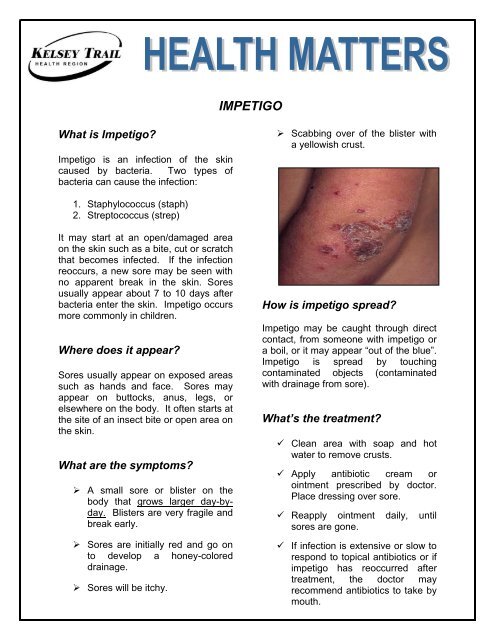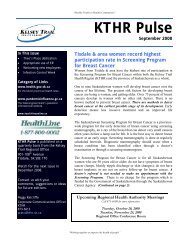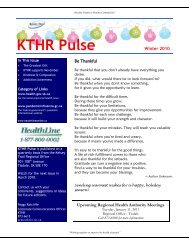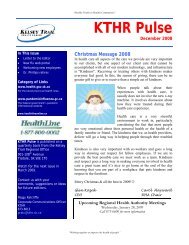Impetigo - Kelsey Trail Health Region
Impetigo - Kelsey Trail Health Region
Impetigo - Kelsey Trail Health Region
Create successful ePaper yourself
Turn your PDF publications into a flip-book with our unique Google optimized e-Paper software.
IMPETIGO<br />
What is <strong>Impetigo</strong>?<br />
<strong>Impetigo</strong> is an infection of the skin<br />
caused by bacteria. Two types of<br />
bacteria can cause the infection:<br />
‣ Scabbing over of the blister with<br />
a yellowish crust.<br />
1. Staphylococcus (staph)<br />
2. Streptococcus (strep)<br />
It may start at an open/damaged area<br />
on the skin such as a bite, cut or scratch<br />
that becomes infected. If the infection<br />
reoccurs, a new sore may be seen with<br />
no apparent break in the skin. Sores<br />
usually appear about 7 to 10 days after<br />
bacteria enter the skin. <strong>Impetigo</strong> occurs<br />
more commonly in children.<br />
Where does it appear?<br />
Sores usually appear on exposed areas<br />
such as hands and face. Sores may<br />
appear on buttocks, anus, legs, or<br />
elsewhere on the body. It often starts at<br />
the site of an insect bite or open area on<br />
the skin.<br />
What are the symptoms?<br />
‣ A small sore or blister on the<br />
body that grows larger day-byday.<br />
Blisters are very fragile and<br />
break early.<br />
‣ Sores are initially red and go on<br />
to develop a honey-colored<br />
drainage.<br />
‣ Sores will be itchy.<br />
How is impetigo spread?<br />
<strong>Impetigo</strong> may be caught through direct<br />
contact, from someone with impetigo or<br />
a boil, or it may appear “out of the blue”.<br />
<strong>Impetigo</strong> is spread by touching<br />
contaminated objects (contaminated<br />
with drainage from sore).<br />
What’s the treatment?<br />
Clean area with soap and hot<br />
water to remove crusts.<br />
Apply antibiotic cream or<br />
ointment prescribed by doctor.<br />
Place dressing over sore.<br />
Reapply ointment daily, until<br />
sores are gone.<br />
If infection is extensive or slow to<br />
respond to topical antibiotics or if<br />
impetigo has reoccurred after<br />
treatment, the doctor may<br />
recommend antibiotics to take by<br />
mouth.
Your doctor can diagnose impetigo by<br />
looking at the sore and on the basis of<br />
your medical history or may send a<br />
sample of fluid or crust from the sore to<br />
a lab for diagnosis.<br />
ALWAYS follow the advice of your<br />
medical care provider.<br />
Special cleaning precautions<br />
Cloths used to scrub the sores<br />
should be thrown away.<br />
Towels and face cloths used by<br />
the infected person should not be<br />
shared with other household<br />
members.<br />
Personal items such as bed<br />
sheets, towels and cloths should<br />
be washed in hot water and<br />
soap/detergent.<br />
Preventing <strong>Impetigo</strong><br />
‣ Wash your hands frequently and<br />
encourage others in your<br />
household to wash their hands.<br />
‣ Refrain from hand-to-mouth,<br />
hand-to-nostril touching.<br />
‣ Keep cuts/scratches/bites clean<br />
and covered.<br />
‣ Avoid direct contact with anyone<br />
suspected of having impetigo.<br />
‣ Avoid contact with clothing or<br />
personal articles of anyone with<br />
impetigo.<br />
‣ Regularly check children for signs<br />
of impetigo.<br />
‣ If you suspect impetigo see your<br />
doctor immediately.<br />
For further information contact your local<br />
Public <strong>Health</strong> Office or view the<br />
following website:<br />
Tisdale 873-8282<br />
Nipawin 862-0761<br />
Kelvington 327-4723<br />
Hudson Bay 865-2634<br />
Should my child stay home?<br />
Yes. Your child should stay home from<br />
school or daycare until the sores are dry<br />
or until 24 hours after the treatment<br />
begins.<br />
Melfort 752-6310<br />
Cumberland House 888-2244<br />
References:<br />
Communicable Disease Manual - Saskatchewan<br />
<strong>Health</strong> (March 1999)<br />
New Zealand Dermatological Society<br />
(http://dermnetnz.org/bacterial/impetigo.html)

















